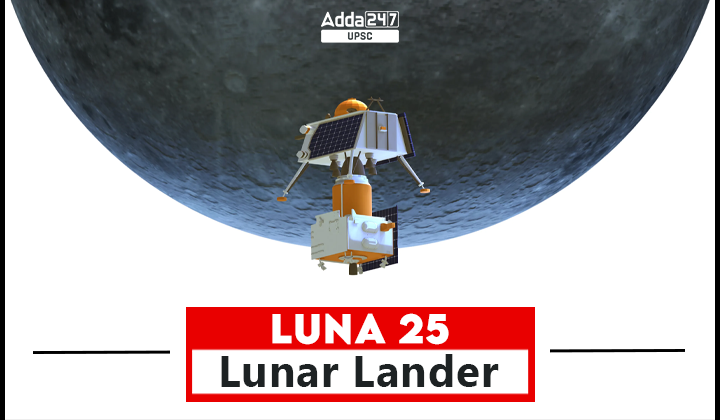Table of Contents
Luna 25 Mission 2023: Roscosmos’ significant Luna 25 lunar exploration mission aims to deepen our understanding of the mysterious southern polar region of the moon. Luna 25 is equipped with a wide range of cutting-edge scientific instruments, including cameras, spectrometers, and drilling tools, and is in a position to examine and evaluate the composition, geology, and potential water ice accumulations on the Moon’s surface.
Luna 25 Mission 2023
Luna 25 Mission 2023: Moscow’s ambitious lunar aspirations were met with disappointment as the Russian spacecraft Luna-25 experienced an untimely crash on the Moon before its intended landing, thus dashing the significant plans the city had for lunar exploration in advance of human ventures to this harsh environment.
Engineered with the purpose of investigating the uncharted lunar realm over a year, the spacecraft encountered setbacks even prior to its landing attempt, succumbing to glitches during a pre-landing procedure conducted above the lunar surface. Ultimately, Luna-25 met its unfortunate end, impacting the lunar terrain on August 19, 2023, at 11:57 UTC due to a technical malfunction.
Luna 25 Mission 2023 Objective
- Luna 25 Launch: On August 11, Roscosmos, the Russian space agency, initiated the Luna 25 spacecraft’s journey, deploying it atop a Soyuz 2 rocket.
- Comprising a lander, Luna 25 aimed to achieve a soft landing near the moon’s southern pole, with a primary focus on investigating lunar soil properties and atmospheric conditions.
Luna 25 Mission 2023 Reasons to Crash
- Unfortunately, Roscosmos announced on August 20 that Luna 25 2023 encountered a technical malfunction, resulting in a crash landing on the lunar surface
- Excessive Thrust Scenario: This speculation centers on the possibility that Luna 25 applied an excessive thrust during the orbital adjustment maneuver, leading it to veer uncontrollably toward the lunar surface.
- Exploration Challenges: The recent setback underscores the complexities and challenges inherent in lunar exploration, highlighting the demanding nature of space missions
- Mission Implications: Luna 25’s failure, coupled with Western sanctions restricting component imports, could potentially delay the launch dates of missions 26 and 27 beyond their projected 2027 and 2028 timeframe.
Significance and Future Implications of Luna 25 Mission 2023
- Scientific Endeavor: The Luna 25 mission 2023 had aspired to contribute vital insights into the characteristics of lunar soil and the moon’s atmosphere, advancing our understanding of Earth’s celestial neighbor.
- Long-standing Ambition: The inception of the Luna 25 Mission 2023 spans over two decades, originally titled Luna-Glob, with subsequent renaming to align with the historic Luna series, the last installment of which debuted in 1976.
- Access to Lunar Surface: Roscosmos, in its official statement, cited a pivotal objective of securing Russia’s reliable access to the moon’s surface, reflecting the rising prominence of lunar exploration in contemporary space endeavors.
- International Lunar Landscape: Amidst the international landscape, Russia and China’s collaborative leadership in the International Lunar Research Station (ILRS) contrasts with the U.S.-led Artemis Accords approach, highlighting varying approaches to lunar exploration strategies.
Luna 25 Mission 2023 and Chandrayaan 3
- Absence of Competitive Dynamic: Both missions shared a similar launch timeframe and soft-landing goals, yet key factors influenced their synchronization.
- Complex Parameters: Mission timing is intricate, shaped by elements like launch vehicle capabilities, spacecraft mass, trajectory intricacies, and lunar illumination conditions.
- Individual Development Trajectories: Chandrayaan 3’s evolution since 2019 contrasts with Luna 25’s longer inception timeline since the early 2010s, implying distinct developmental contexts.
- Intrinsic Mission Goals: Luna 25 Mission 2023 and Chandrayaan 3 pursued distinctive goals based on their individual project trajectories, technical considerations, and historical partnerships.
- Absence of Race Dynamic: Ultimately, the comprehensive analysis underscores that the missions were not in a competitive race, as their timelines and underlying motivations substantially differ.
Luna 25 Mission 2023 Geo strategic & Symbolic Dimensions
- Demonstrative Gesture: Emphasizing the resilience of Russia’s economy, including its space sector, in the face of international sanctions triggered by the 2022 Ukraine incursion.
- Sanctions Aftermath: The mission’s potential dual role in showcasing economic and technological strength could signal Russia’s intent to maintain its standing as a spacefaring nation amidst geopolitical challenges.
Evolving Lunar Collaborations
Past Moon Station Initiative: Russia had initiated a partnership with NASA to construct a lunar space station before withdrawing from the endeavor in 2021, with its involvement already deemed limited.
ILRS Roadmap: Roscosmos’ engagement in the International Lunar Research Station (ILRS) includes plans for Luna missions 26 and 27 in the initial phase, aimed at technology demonstration and site selection for future lander initiatives.
Diminished Role Possibility: The compounding effects of mission failures and geopolitical factors raise the possibility of Russia’s diminished role in upcoming lunar exploration initiatives, casting uncertainty on its contribution to future lunar missions.
Consequences of the Ukraine Crisis
Diplomatic Backlash: Following Russia’s Ukraine invasion, it encountered widespread international backlash, leading to imposed economic sanctions and diplomatic repercussions.
- Tracking System Loss: A less-discussed effect of the crisis was Russia’s loss of access to global satellite tracking networks operated by various nations across the world.
- Communication Hub Limitations: Roscosmos faced constrained communication options for Luna 25 due to the loss of international tracking capabilities.
- Limited Contact Points: The spacecraft could only establish communication with Earth through three stations, two located within Russia and one situated in Russia-annexed Crimea.
- Time and Geographical Constraints: Communication with Luna 25 was only feasible when the moon passed over Russian territory, severely limiting the available communication window.
- Reduced Salvage Opportunity: The smaller communication timeframe reduced scientists’ chances of troubleshooting the mission’s issues and attempting to salvage the operation.
| Relatable Articles | |
| Moon landing | Chandrayaan 3 |
| Emergency in India | Centre State Relations |
| Special Provisions Act | Cooperative Societies |




 TSPSC Group 1 Question Paper 2024, Downl...
TSPSC Group 1 Question Paper 2024, Downl...
 TSPSC Group 1 Answer key 2024 Out, Downl...
TSPSC Group 1 Answer key 2024 Out, Downl...
 UPSC Prelims 2024 Question Paper, Downlo...
UPSC Prelims 2024 Question Paper, Downlo...





